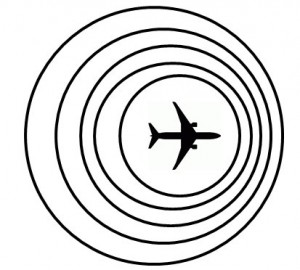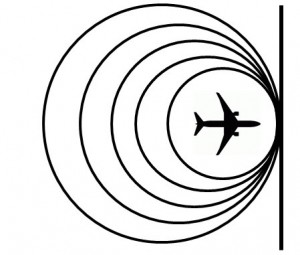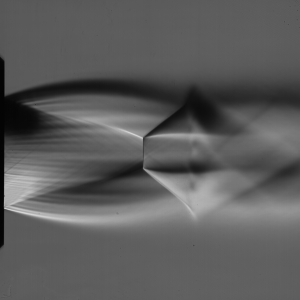Introduction:
All fluids are compressible to some degree, so it could be said that in a strict sense, all fluid flow is compressible flow. From a practical standpoint however, compressibility effects only become relevant under certain flow conditions. Compressibility effectively measures how much the density of a fluid changes as you change the pressure exerted on it. Liquids are almost incompressible; try squeezing a plastic water bottle with the lid on and no air in it. When air is flowing at low speed, we can get away with pretending it is incompressible as well, when it comes to the governing equations of fluid mechanics.
Once we start moving a little faster though, we can’t get away with this shortcut anymore, and we need to include a consideration of varying density in our equations of fluid motion. This is what we call “compressible flow”.
Sound Waves:
The speed at which sound propagates through a medium is related to the compressibility of that medium: the more compressible, the slower the speed of sound. The degree to which we have to consider compressibility when studying fluid flow is also linked to the speed of sound: as our flow speeds get closer to the speed of sound, compressibility becomes more important.
When our fluid is moving faster than the speed of sound, we are now dealing with “supersonic” flow. In supersonic flow, all kinds of strange, counter-intuitive things start happening. One of the more interesting phenomena is the formation of shock waves.
Shock Waves:
What is a shock wave?
That’s a somewhat difficult question to answer. A shock wave is really just a region of very high property gradients – a place where things change very very quickly. Across a shock wave, the flow velocity, pressure, density and temperature all change extremely quickly. In normal laboratory conditions, a shockwave might be only a few micrometers thick (a few one-millionths of a meter). Over this distance, you might see as much as a tenfold change in pressure (or in the case of very strong shocks, much higher still). In some of the images on this website, shockwaves appear to be almost solid, physical objects. However all we are really seeing is a region of space where large changes are occurring.
How does a shock wave form?
Let’s imagine a plane flying along, well below the speed of sound. As it flies along it produces noise, noise from its engines, noise from its passage through the air (and possibly even a crying baby or two). The sound waves associated with this noise propagate outwards in all directions, at the speed of sound. If the plane is travelling with reasonable speed (but still subsonic), you can imagine that the waves in front might bunch up a little compared with the waves behind it. This is the well-known doppler effect (you can hear this easily when a vehicle with a siren drives past)

Now let us imagine that the plane accelerates up to the speed of sound. It’s still producing noise: engines still going, babies probably still crying. Now however, the waves can’t get ahead of the plane, since the plane itself is moving at the same speed as the sound waves. This means if we’re standing ahead of the plane, there is no way to hear it coming – it will reach us at the same time the sound waves do! All the acoustic energy associated with those sound waves will now reach us at the same time, rather than being spread out. When we compress a whole lot of sound waves together into a single wave, what we have is now essentially a shock wave.

If the plane accelerates to speeds higher than the speed of sound, it will now start outrunning its own sound waves! This will form a shock wave in a cone behind the aircraft. If an aircraft like this flies over head, we won’t hear it until it’s gone past us and the edge of that cone (called a Mach cone) reaches us. The more supersonic the aircraft is, the further past us it will be before we hear it, and the louder it will be when we do!

This is one way to visualize how a shock wave forms – acoustic waves cannot propagate faster than the speed of sound, so you get a build-up of waves in one place, resulting in a shock wave.
Another way to imagine it is as follows: When the aircraft is subsonic, acoustic waves travel ahead of the aircraft, which essentially tells the air that something is coming, and it’s going to have to get out of the way. This gives the air time to adjust and flow smoothly over the aircraft. If the information cannot propagate ahead of the aircraft in the form of an acoustic wave, then there is no way for the air to know the aircraft is coming. One second it’s just sitting there, minding its own business, the next second there is an aircraft right on top of it! Since the air and the aircraft cannot exist in the same place at the same time, something is going to have to push the air out of the way. If acoustic waves have not done this in a nice gentle manner before the aircraft arrives, a shock wave will do it much more violently, much closer to the aircraft.
Why do shock waves matter?
Shock waves are inherently inefficient processes. Nature doesn’t like it when you change things too quickly, and a shock wave is the ultimate example of rapid change. While energy is conserved across a shock wave (energy is always conserved!), the entropy of a fluid increases through a shock wave. Entropy is a measure of the “quality” of energy, with lower entropy being higher quality energy. In this instance, quality means energy that is easy for us to use. So in aerodynamics, shock waves are an unavoidable but unpleasant fact of life when dealing with supersonic flow. In aeroacoustics (the production of noise by fluid flow), shock waves make all our noise problems worse. However, there’s no point ignoring them; by studying the mechanisms that result in the formation and stability of shock waves, we can hope to minimize inefficiencies and sound production.
On a more positive note, they do look very pretty!
